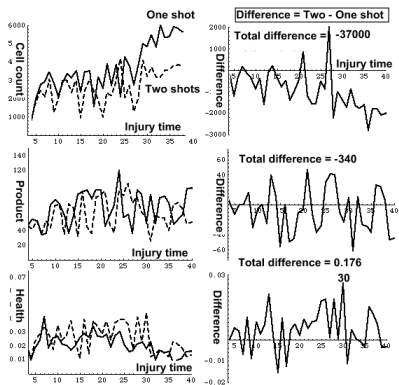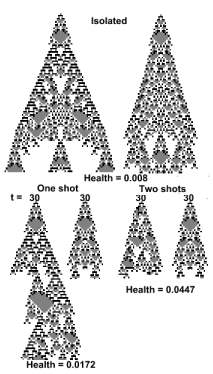 |
Immunity
We continue the previous experiment
where CA-1 was injured at rising times. Does this treatment strengthen
the system or weaken it? In order to find out, CA-1 was injured twice. First at injury time = 4. The second injury was applied at rising times.
 |
Following the second injury, cell count and production generally declined, while health = production / cell count, improved. At t = 30 the system was healthiest. Some CA are depicted below
 |
The experiment might be regarded as immunizing a CA system.
When children are immunized against disease like whooping cough they receive
two or more shots of weakened microbes.
From then and on, the immune
system will remember how to handle whooping cough microbes. The immune system has a memory which stores
its encounters with invaders,
known as foreign antigens.
System memory
The experiment indicates that our system has a memory. It remembered the first injury, and became healthier after the second. At
t = 30, . after one shot its health was
0.0172 and it rose after the second shot to 0.0447. If it would not remember that it got the first shot,
the system would not become healthier. Imagine immunizing a Random walk,
it will remain a Random walk. Our system acquires knowledge.
The memory encompasses the entire system, and is written
in its structure. Change one bit
and the memory will also change. The experiment shows that the system
is capable to learn. Actually
injury has two meanings. 1. It is a threat which might kill the system. 2. It is a challenge
which teaches the system, and
enhances its knowledge.
Take the bugs which cause sore throat. On one hand they
pose a threat to spread into the lung and
cause a dangerous pneumonia. The physician rushes therefore to kill them with antibiotics. On
the other hand, if killing
the bugs too soon, the immune system will not have enough time to develop
immunity. Learning takes time.
Observe the health difference curve, and imagine stopping
the experiment at t = 3. The system would be less healthy than if
you would wait until t = 30. The system needs time to build up its
health.
Human memory
Medicine teaches that our memory is stored in the brain. Like computer memory
it is supposed to store images or other data. Yet our memory has to store
more than that. Imagine that you decide to stand up. You exercise a faculty
which you learned as a child, which means that you remember how to stand
up, and now apply this knowledge. While the
brain remembers how to coordinate muscles, there is more to it. Myriad
other processes participate
in standing, and the memory of their coordination is not stored in the brain.
It is stored in the entire organism. Like the memory of our experimental
system. This memory is stored in our WOB.
When remembering the first injury, our system did not store data. It stored
action. It knows how to improve its health. While our brain may store data
like a computer WOB stores actions.
The experiment illustrates an important feature of WOB computer. Its memory will be distributed, and will store actions.
Set up
injuryrange=1; injury1=4; injurytime = *; effect[1, 2, 1.6, sa[[1]]], effect[2,1,
1.9, sa[[2]]];
Further reading:
WOB boosting